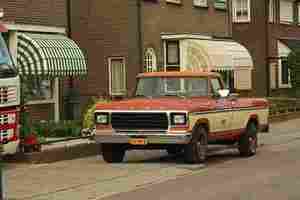Ford’s e-concept pickup truck turns my old-school mode on
Remember Ford‘s 1978 F-100 pickup truck?



The automaker has used it to create a reimagined electric vehicle concept and it’s called the F-100 Eluminator .
Take a look at the reinvented oldie:
Basically, Ford has unveiled the concept car to showcase the benefits of electric propulsion and, in turn, to promote its first electric crate motor from Ford Performance Parts, designed to electrify conventional vehicles — from vintage cars to modern trucks and SUVs.
You can buy the e-crate motor online at authorized Ford parts warehouses and dealers for $3,900. If you’re a conversion aficionado, I’d say that’s a pretty decent deal.
If you ask me, I find the F-100 Eluminator concept truck an absolute beauty and I’m a big fan of giving new sustainable life to vintage vehicles.
Whether a classic car is still “classic” if converted to an EV is, however, a long discussion and as I’ve already shared my opinion on the matter I won’t bore you again with my arguments.
I do believe that Ford’s e-crate motor is a great idea for making conventional vehicles environment-friendly, but I’d like to say that if we really want a fully zero-emission transportation, we have to ditch cars altogether.
And, in fact, there’s another type of classic vehicle that doesn’t involve a car’s polluting manufacturing process: the carriage!
Just imagine an e-crate motor designed for carriages! It would require less electricity to power it (so, we’re saving on energy consumption) and we wouldn’t have to endanger the horse species either.
Yes, yes , I’m totally aware that this just can’t happen in the modern era, but still that’s the ultimate classic vehicle conversion. And it’d be very cool going to work with your electrified carriage, ideally wearing a black top hat.
Do EVs excite your electrons? Do ebikes get your wheels spinning? Do self-driving cars get you all charged up?
Our top 10 mobility stories of 2021
As you can imagine, mobility is a massive sector – it’s everything from cars to ebikes to trains and buses.

Here at Shift, we’re keen to cover the lot, as well as topics like battery innovation , renewable energy (particularly solar and hydrogen), and EV charging.
Emerging mobility solutions like hyperloops , eVTOLs, autocycles , and hovercrafts make us look forward to the future. Technology moves fast, and we strive to create explainers into the use of AI, blockchain , and metaverse in the mobility space.
We also like to make space for fun and entertainment, ridicule Elon Musk every now and then, and cover the latest vehicles from auto shows and product launches.
However, writing can be hit and miss. Sometimes we spend ages writing something only to have a less than stellar reception.
Or a piece will unexpectedly get likes and shares, seemingly out of nowhere (thanks, Reddit).
In the current era of digital journalism, statistics matter to help us guide our priorities in bringing you news and articles that are interesting, informative, engaging, and inspiring.
But, we also write at mobility because we like writing: we like talking to people, we like working on an angle and researching. We like thinking about what’s not being said… So the team here at SHIFT is sharing some of the favorite mobility stories we wrote in 2021. Take a read, and feel free to share them among your networks!
Here’s how autonomous cars could help remote and unpopulated areas
This article was written by Yann Arnaud, Director of Customer Needs and Innovation at MACIF on The Urban Mobility Daily , the content site of the Urban Mobility Company, a Paris-based company which is moving the business of mobility forward through physical and virtual events and services. Join their community of 10K+ global mobility professionals by signing up for the Urban Mobility Weekly newsletter . Read the original article here and follow them on Linkedin and Twitter .

The Business of Mobility is an Urban Mobility Company series highlighting some of the most successful new businesses in the mobility sector. Featuring a closer look at the way in which companies stand out, CEOs, Directors and other c-level executives elaborate on what it takes to turn a great idea into a great company.
Yann Arnaud is President of the Steering Committee on AVs for a Movin’On Community of Interest project. He explains here how autonomous vehicles can bring life and economic dynamism back to the parts of France that need it most. Yann is also Chairman of the Digital Commission and the Connected and Autonomous Vehicles working group of the French Insurance Federation.
Mention ‘Autonomous Vehicle’ and most people picture a man – probably white and possibly a busy executive – reading the news, or replying to emails, while his luxury electric vehicle navigates the traffic by itself. This reality is already upon us, with many automakers releasing Level 3 (conditional automation) vehicles into the market.
According to this image, AVs are a natural continuation of the classic single-car-ownership model; i a technological disruption that does not address the social and economic issues of our day.
The Movin’On Community of Interest is a working group that brings together several ecosystem stakeholders to develop a common vision and experiment new mobility solutions togethers. We are leading one of them, dedicated to shifting the discussion away from technological advance for its own sake and toward the use of technology to promote social good.
Movin’On , created and inspired by Michelin, is gathering collective and individual change makers and giving them the means to innovate together for more mobility with less impact. Besides Macif and Michelin, there are other major players from the private sector involved in the Community of Interest to recontextualize mobility innovation in terms of social impact. These include BNP Paribas Cardif, Deloitte, Faurecia, Kantar, Maif, Microsoft, Orange, SNCF and Vinci; as well as key actors from government, civil society and the scientific community.
Movin’On has numerous interdisciplinary teams within its LAB, a think and do tank, engaged in answering questions like: ‘How to reshape last mile delivery operations and experience for good?’ and ‘How can we securely share data to create value and improve sustainable mobility?’. Our Community of Interest is dedicated to answering: ‘How can we encourage the adoption of autonomous vehicles through sustainable and inclusive mobility insights?’.
In 2020, we participated in studies carried out by the Védécom Institute, who specialise in the subject of mobility and autonomy. One of our striking findings was that there is overwhelming bias in the media and the popular imagination for ‘technopush’, whereby technology – not social good – drives interest and publicity. Of the 100 000 or so articles on AVs we came across, only 185 discussed the social impact of this new technology and the possibilities for inclusive and sustainable transport.
It’s a bit like social media, which was first seen as an unvarnished good, before – as Gartner’s Hype Cycle describes it – the ‘Peak of Inflated Expectations’ gave way to the ‘Trough of Disillusionment’. Our research suggests that the French public intuits the potential for disillusionment; they’re prepared to support AVs, so long as they prove to be safe and that they expand employment opportunities and reduce environmental impact.
Interestingly, rural areas were less supportive of AVs. But if we have our way, these environments will benefit greatly from cheap, efficient, carbon-light solutions to getting around, finding work and building communities.
How can we convince the public, as well as major institutional players, that the real opportunity for AVs is not as a continuation of the traditional mobility model, but as a positive disruption that boosts local economies and expands access to millions of the underserved? This notion is encapsulated in our Movin’On Community of Interest motto: ‘Mobility for all, Autonomy for all’.
We believe this can be achieved by using AV technology for shared electric shuttles that mix on-demand elements of ride-hailing with traditional public transport elements of routes and timetables. If a country like France – which has large areas that are sparsely populated – can get this right, it will do unimaginable good for those outlying towns, villages and suburbs where millions find their lives and livelihoods constrained by lack of mobility options.
I live in Coulonges-sur-L’Autize, a small village 25-minutes’ drive north of MACIF’s headquarters in Niort. It’s a joy to live close to a Regional Natural Park (Marais Poitevin) and not too far from the beauty spots along the Bay of Biscay coastline. And yet I see that a village or small town can be a prison for those – be they a single mother or elderly couple – without ready access to mobility.
We will know that the initiative has succeeded when we’ve increased the sharing of assets, decreased environmental impact, and rejuvenated business and social activity in the high street, particularly for smaller towns and villages.
If shared autonomous shuttles really are key to reversing the decline of peri-urban areas, then why don’t we see the big OEMs talking more about it? Clearly, the commercial argument for the solution has not been properly made. Our committee is of the opinion that not only can AVs improve mobility access for underserved areas, but that the model is commercially viable.
Currently, AVs are expensive because the data and intelligence must be self-contained in the vehicle. But if AVs operated within a geofenced area, along discrete routes and supervised centrally, then the intelligence and data would be shared across the system, reducing costs. If this solution for a certain suburb or village proves to be scalable, then it means we could duplicate the model across the country.
Our Community of Interest began in 2020 and rolls out of three yearly phases: explore, prepare and test. By 2022 we should be able to verify if indeed a replicable model for widespread AV use in sparse areas is possible. In the meantime, it’s important that insurance companies like Macif consider the risk and liability problems posed by AVs.
In the future, it’s possible that an autonomous system will reduce accident risk to zero. But current reality says AVs and non-AVs are going to be operating on the same roads for some years to come. With fears around automation and artificial intelligence relegating humans to irrelevance, it is important that a company like Macif – which was founded for mutual benefit in protection of life, family and property – leads the discussion.
AVs are set to disrupt millions of truck-driving, delivery and ride-hailing jobs. We need to think about how technology can ameliorate the digital divide and expand opportunities to those on the margins of economic activity. There is no reason why a country like France cannot use AVs to boost economic dynamism and social activity in sparsely populated areas, improving the lives of millions.
Do EVs excite your electrons? Do ebikes get your wheels spinning? Do self-driving cars get you all charged up?
Then you need the weekly SHIFT newsletter in your life. Click here to sign up .